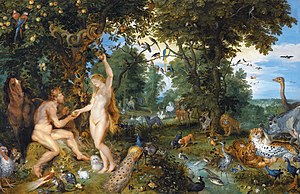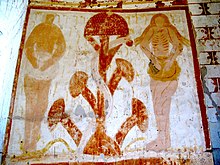Forbidden fruit

In Jewish mythology, forbidden fruit is a name given to the fruit growing in the Garden of Eden which God commands mankind not to eat. In the biblical story, Adam and Eve eat the fruit from the tree of the knowledge of good and evil and are exiled from Eden:
And the Lord God commanded the man, saying, Of every tree of the garden thou mayest freely eat:
But of the tree of the knowledge of good and evil, thou shalt not eat of it: for in the day that thou eatest thereof thou shalt surely die.
— Genesis 2:16–17, King James Version[1]
As a metaphor outside of the Abrahamic religions, the phrase typically refers to any indulgence or pleasure that is considered illegal or immoral.
Biblical story
The story of the
In Genesis 3, a serpent tempts the woman:
And the serpent said unto the woman, Ye shall not surely die:
For God doth know that in the day ye eat thereof, then your eyes shall be opened, and ye shall be as gods, knowing good and evil.
— Genesis 3:4–5, KJV[2]
Desiring this knowledge, the woman eats the forbidden fruit and gives some to the man, who also eats it. They become aware of their nakedness and make fig-leaf clothes, and hide themselves when God approaches. When confronted, Adam tells God that Eve gave him the fruit to eat, and Eve tells God that the serpent deceived her into eating it. God then curses the serpent, the woman, then the man, and expels the man and woman from the Garden before they ate of the tree of eternal life.
Quranic story
According to the
Surah Al-A'raf 7:20–22 describes
Then their Lord called out to them, "Did I not forbid you from that tree and ˹did I not˺ tell you that Satan is your sworn enemy?"
Gnostic story
A Gnostic interpretation of the story proposes that it was the archons who created Adam and attempted to prevent him from eating the forbidden fruit in order to keep him in a state of ignorance, after the spiritual form of Eve entered the Tree of the Knowledge of Good and Evil while leaving a physical version of herself with Adam once she awakened him. However, the forces of the heavenly realm (Pleroma) sent the serpent as a representative of the divine sphere to reveal to Adam and Eve the evil intentions of their creators. The serpent succeeded in convincing them to eat the fruit and become like gods, capable of distinguishing between good and evil.[5]
Identifications and depictions
The word fruit appears in Hebrew as פֶּ֫רִי, pərî. As to which fruit may have been the forbidden fruit of the
In Islamic tradition, the fruit is commonly either identified with wheat or with grapevine.[9]
Apple
In
The
Grape
Rabbi Meir says that the fruit was a grape, made into wine.[12] The Zohar explains similarly that Noah attempted (but failed) to rectify the sin of Adam by using grape wine for holy purposes.[13][14] The midrash of Bereishit Rabah states that the fruit was grape,[15] or squeezed grapes (perhaps alluding to wine).[16] Chapter 4 of 3 Baruch, also known as the Greek Apocalypse of Baruch, designates the fruit as the grape. 3 Baruch is a first to third century text that is either Christian or Jewish with Christian interpolations.[17]
Fig
The Bible states in the book of Genesis that Adam and Eve had made their own fig leaf clothing: "And the eyes of them both were opened, and they knew that they were naked; and they sewed fig-leaves together, and made themselves girdles".
Pomegranate
Proponents of the theory that the Garden of Eden was located somewhere in what is now known as the Middle East suggest that the fruit was actually a pomegranate, as it is one of the earliest domesticated plants on the Eastern Mediterranean.[21] The association of the pomegranate with knowledge of the underworld as provided in the Ancient Greek legend of Persephone may also have given rise to an association with knowledge of the otherworld, tying-in with knowledge that is forbidden to mortals. It is also believed Hades offered Persephone a pomegranate to force her to stay with him in the underworld. Hades is the Greek god of the underworld and the Bible states that whoever eats the forbidden fruit shall die.
Wheat
Rabbi Yehuda proposes that the fruit was wheat, because "a baby does not know to call its mother and father until it tastes the taste of grain."[12]
In Hebrew, wheat is khitah, which has been considered to be a pun on khet, meaning "sin".[6]
Although commonly confused with a seed, in the study of botany a wheat berry is technically a simple fruit known as a caryopsis, which has the same structure as an apple. Just as an apple is a fleshy fruit that contains seeds, a grain is a dry fruit that absorbs water and contains a seed. The confusion comes from the fact that the fruit of a grass happens to have a form similar to some seeds.[22]
Mushroom

A fresco in the 13th-century
Banana
Several proponents of the theory that the forbidden fruit was a banana exist dating from the 13th century.
In Nathan HaMe'ati's 13th-century translation of Maimonides's work The Medical Aphorisms of Moses, the banana is called the "apple of Eden".[28][29] In the 16th century, Menahem Lonzano considered it common knowledge in Syria and Egypt that the banana was the apple of Eden.[30]
Coco de mer
Charles George Gordon identified the forbidden fruit of the tree of knowledge with the coco de mer.[citation needed]
Parallel concepts
This section needs expansion. You can help by adding to it. (July 2017) |
Greek mythology
The similarities of the story to the story of Pandora's box were identified by early Christians such as Tertullian, Origen, and Gregory of Nazianzus.[31]
Some may also make the comparison to a more well known “fruit” of our own times. That being magic mushrooms. Some people partake in these mushroom which they may believe gives them more knowledge on the world and life.
See also
- Grapefruit, originally named the "forbidden fruit" of Barbados.[32]
- Medieval popular Bible
- Ningishzida
- Pomme d'Adammo
- Serpent seed
References
- ^ Genesis 2:16–17
- ^ Genesis 3:4–5
- ^ Quran 7:19 ˹Allah said,˺ "O Adam! Live with your wife in Paradise and eat from wherever you please, but do not approach this tree, or else you will be wrongdoers."
- ^ Quran 7:20-22
- ISBN 9781474472180.
- ^ a b c d The Straight Dope: Was the forbidden fruit in the Garden of Eden an apple?
- ^ The Fig: its History, Culture, and Curing, Gustavus A. Eisen, Washington, Govt. print. off., 1901
- ^ 1 Enoch 31:4Template:Bibleverse with invalid book
- ISBN 9780873957274, p. 82.
- ^ https://biblehub.com/topical/a/apple.htm, Retrieved 2023-01-01.
- ^ E. Cobham Brewer (1810–1897). Dictionary of Phrase and Fable. 1898. "Adam's Apple"
- ^ a b Berachot 40a; Sanhedrin 70a.
- ^ Zohar Noah 73a
- ^ The Zohar: The First Ever Unabridged English Translation, with Commentary; Rabbi Michael Berg, ed., Vol. 2, pp.388-390
- ^ Bereishit Rabah 15:7
- ^ Bereishit Rabah 19:5
- ^ 3 Baruch, Chapter 4, available at: http://www.ma.huji.ac.il/~kazhdan/Shneider/apocr2010/3%20Baruch%20OTP.pdf
- ^ Genesis 3:7
- ^ Berachos 40a; Sanhedrin 70a
- ^ "High Art: Were Botticelli's Venus And Mars Stoned?". NPR. 12 June 2010. Retrieved 19 June 2019.
- ISBN 9780199549061.
- ISBN 978-1-4496-4884-8.
Perhaps the simplest of fruits are those of grasses (all cereals such as corn and wheat)...These fruits are caryopses.
- ISBN 0-8493-0118-1.
- ^ "Food Of The Gods (Terence McKenna) [FULL]". YouTube. 24 July 2011. Archived from the original on 2021-11-17.
- ^ "John Allegro, 65; Aided Deciphering of Dead Sea Scrolls", obit., NY Times
- ISBN 978-0-8028-6333-1, pp. xii-xiii
- ^ Allegro, John M. (1970). The Sacred Mushroom and The Cross: A study of the nature and origins of Christianity within the fertility cults of the ancient Near East. Garden City, New York: Doubleday., re-released in a new edition by Gnostic Media Research & Publishing in 2009
- ^ Ari, Zivotofsky (May 2017). "What's the Truth About The Apple In The Garden Of Eden?". Jewish Action. 77 (4) – via Issu.
- ^ Altschule MD, Mark (March 1983). "The Medical Aphorisms of Moses Maimonides". Arch Intern Med. 624: 132 – via JAMA Network.
- ^ Lonzano, Menahem; Book, Start this, Ma'arich (מעריך) (PDF), retrieved 2020-03-10
- ISBN 9781575910628.
- OCLC 16947184.
External links
- Genesis 2:16–17 – English–Hebrew comparison at mechon-mamre.org
